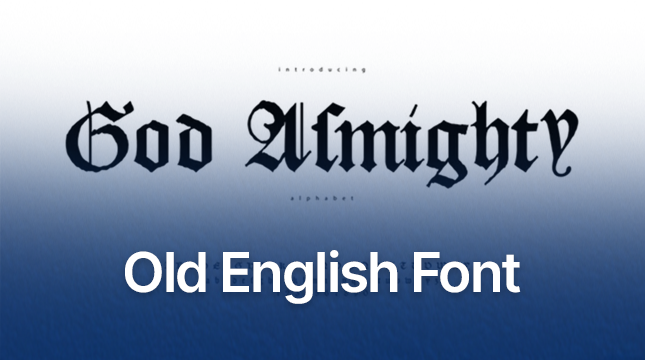This website uses cookies so that we can provide you with the best user experience possible. Cookie information is stored in your browser and performs functions such as recognising you when you return to our website and helping our team to understand which sections of the website you find most interesting and useful.
Old English Font Trends to Watch in and Beyond

The allure of the past is undeniable, and typography is no exception. Old English fonts, also known as blackletter fonts, transport us back to a time of medieval manuscripts and grand tapestries. Their ornate letterforms and dramatic flourishes imbue any text with a sense of history and mystery.
Origins and Evolution
Old English, also known as Blackletter or Gothic script, emerged in Europe during the 12th century. Initially developed for manuscripts and later adopted for printed books, it became synonymous with medieval literature and formal documents. The distinctive features of Old English fonts include:
- Sharp Angles and Dense Lines: Letters are often composed of straight lines and sharp angles, giving them a bold and imposing appearance.
- Intricate Detailing: Flourishes and decorative elements adorn the letters, reflecting the craftsmanship of scribes who meticulously inked each stroke.
- Distinctive Capitals: Capital letters, or versals, in Old English fonts are particularly elaborate, often resembling miniature works of art with their intricate designs.
Cultural Significance
Beyond its visual appeal, Old English fonts carry significant cultural weight:
- Literary Heritage: Many iconic literary works, including the first printed Bible by Johannes Gutenberg, were set in Blackletter typefaces, cementing their association with knowledge and learning.
- Identity and Tradition: In heraldry and official documents, Old English fonts symbolize tradition, authority, and a connection to historical roots.
Contemporary Relevance
Despite its medieval origins, Old English typography continues to captivate contemporary designers and enthusiasts:
- Modern Applications: From logos of prestigious institutions to tattoo designs and movie titles, Old English fonts add a touch of sophistication and timeless elegance to various applications.
- Digital Adaptation: In the digital age, Old English fonts have been adapted and digitized, making them accessible for graphic design projects, websites, and digital art forms.
Tips for Using Old English Fonts
When incorporating Old English fonts into your projects, consider these tips:
- Legibility: Due to its intricate nature, use Old English fonts sparingly and ensure readability, especially in smaller sizes or digital formats.
- Contextual Suitability: Choose fonts that complement the historical or authoritative context of your content, enhancing rather than overshadowing its message.
- Pairing: Balance Old English fonts with modern, sans-serif typefaces for contrast and readability in longer texts or digital interfaces.
Conclusion
Old English fonts stand as a testament to the enduring appeal of historical craftsmanship in typography. Their rich history, ornate designs, and cultural significance continue to inspire and resonate across diverse creative fields. Whether used for decorative purposes or conveying a sense of tradition, these fonts carry with them a legacy that spans centuries, making them a timeless choice in the world of design.
Embrace the elegance of Old English fonts, and let their distinctive charm enrich your next creative endeavor with a touch of medieval grandeur.

Let's Start Your Project
Get free consultation for your digital product idea to turn it into reality!
Get Started






